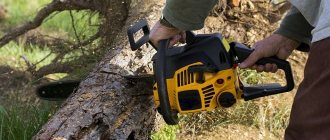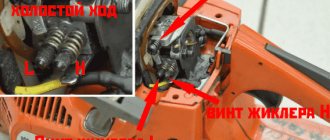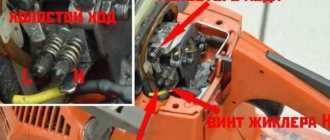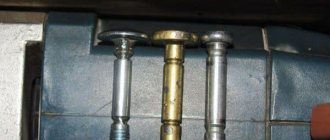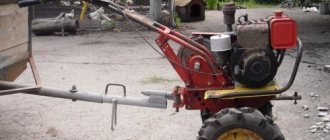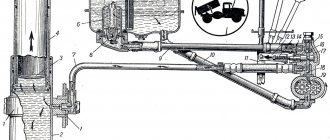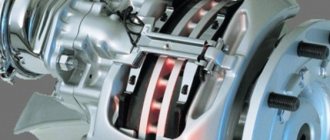A chainsaw is a worthy replacement for hand saws and axes. Today, this tool is available in almost every household - it is indispensable when arranging a personal plot, construction and repair work. Intensive use and improper care of the tool can lead to premature failure. However, it is not at all necessary for the owner of a chainsaw to immediately contact a workshop - many of the malfunctions that can happen to it during operation can be easily eliminated on their own.
- 2 Starting the engine: checking the spark plugs
- 3 Do-it-yourself chainsaw repair: fuel supply system
- 4 Troubleshooting muffler problems
- 5 Repair of the cylinder-piston group (CPG)
- 6 Checking the carburetor and signs that it needs adjustment
- 7 Calibration algorithm and safety precautions when troubleshooting a chainsaw carburetor
- 8 Other malfunctions of chainsaws
- 9 DIY chainsaw repair, video
DIY repair
To carry out repairs at home, you need to have spare parts, tools and appropriate skills. For example, to disassemble a chainsaw, a homemade repair kit may be useful, which will take a very long time to manufacture.
Some modern semi-professional and household devices do not include the appropriate tools for adjusting the carburetor and disassembling the drive sprocket.
Why is primary adjustment needed?
During the first hours of operation, the 2-stroke chainsaw engine requires running-in, on which the quality of its further operation depends. During the running-in process, the carburetor is initially adjusted - the optimal parameters for preparing and supplying the fuel mixture are established.
Initial running-in of the chainsaw: working with thin material
Possible problems
The main problem that arises during repairs is the lack of necessary information on repairs. This is explained by the fact that many foreign manufacturers believe that the saw should be disposed of after a certain period of use. Therefore, many craftsmen have certain doubts, especially when repairing budget models.
But expensive professional models also create certain difficulties:
Of course, it is possible to replace original spare parts with Chinese analogues, but judging by the reviews, this method is of little justification. Such components produce only half the resource.
Types of chain saws and electric saws accepted for repair
In our specialized service center in Moscow, you can repair any types of chain saws, such as: gasoline chain saws or simply chainsaws - equipped with compact gasoline engines, electric chain saws - powered by electricity. networks, cordless chainsaws - I work from a portable battery . All motorized saws are divided into three main professional classes, regardless of their engine type. Household (amateur) chain saws are low-power tools designed for those who use them infrequently, for example, at the dacha to cut down a thick branch in the garden or prepare some firewood. Semi-professional (farm) chain saws are an intermediate link between the household and professional classes; they require part-time work and are suitable for repair and construction work and felling trees, with rest breaks. Professional chain saws are designed for serious year-round work and professional tasks in the sawmill and construction site. Each of the listed types has its own advantages and disadvantages in operation. For example: electric chainsaws are less noisy and cheaper and lighter than gasoline ones, gasoline saws are more powerful and more mobile, they are not tied to an outlet, but they can only be used outdoors due to exhaust gases, while battery-powered ones are almost silent, have a low cost and do not require fuel, are convenient and mobile.
Chainsaw Electric chainsaw Cordless chainsaw
But, unfortunately, both gasoline and electric and cordless chain saws , such useful and convenient garden and construction assistants, can break. Don’t be upset and run out to buy a new fancy model, we are ready to help you and repair any chainsaw in Moscow at a service center! We employ only professional engineers who will quickly identify and eliminate the malfunction of your equipment, in the shortest possible time, and for a reasonable fee, which will be several times less than the cost of a new unit. Of course, for long-term reliable operation, any garden equipment needs timely maintenance and repair, and chain saws are no exception.
Chainsaw design
All chainsaws have the same design, regardless of which device, domestic (Ural, Kedr, Patriot 3816, Carver - Russian production with Chinese partners) or foreign (Shtil, Husqvarna), for example, repairing a Patriot 3816 chainsaw with your own hands will be the same , as well as repairing a foreign device. Main components of the tool:
The general principle of operation of a chainsaw is simple - the master sharply pulls the cord, which starts the engine, and it, in turn, starts the saw blade. Sometimes malfunctions occur in the operation of the device; to eliminate them, you will have to dismantle the saw. Problems that may arise with a chainsaw:
The main problems that arise are related to engine problems (fuel supply, exhaust system, cylinder-piston system and ignition), or minor problems (chain problems, lubrication, tire, oil seal). It is important to look at each problem in more detail .
If the chain is simply broken, it should be replaced with a new one. There shouldn't be any problems solving this problem. Repairing other parts of the saw can take up to several hours.
Problems with the chain lubrication system
If the chain is not supplied with lubricant, the following events may occur:
- Rapid chain wear (blunting of teeth, stretching, tire abrasion)
- Engine wear due to heavy loads placed on the tool
- Worn drive sprocket, which also needs lubrication
Malfunctions of the chain lubrication system and how to fix them yourself
If the chain does not receive oil, the reason may be an insufficient amount of lubricant in the tank, a malfunction of the oil pump, or damage to the channels. The breakdown can be repaired only after determining the exact cause of the chainsaw malfunction.
Fuel supply
In addition to the above-mentioned clogged breather, other problems may arise during the fuel supply. The main obstacles may be:
Clogged fuel filter. To check the device for this malfunction, you need to disconnect the fuel hose and see how the fuel flows. If the flow is weak, the filter may need to be cleaned. The filter device is removed through the filler hole of the tank and cleaned; if the contamination is too strong, it is replaced.
Professionals recommend changing the filter every few months, regardless of contamination.
Lack of fuel. In this case, the problem may lie in several factors. The first is a dirty air filter. The problem is that enough air is not delivered to the carburetor, causing the engine to run poorly. The filter must be removed, cleaned, washed and dried, and then put back.
The second reason is an unadjusted carburetor. It, that is, adjustment is carried out with three screws.
And the last reason is a problem with the integrity of the membrane or contamination of the carburetor channels. As in other cases, it is necessary that the components are dry and clean.
Cylinder-piston group
It happens that the engine does not start or functions poorly due to low pressure in the cylinder. The malfunction may consist of a piston, cylinder or bearings that have become unusable, or piston rings that have sunk. You can look at the problem in general terms; to do this, you need to remove the muffler and inspect the system.
You can measure the compression in the engine by placing a compression gauge in the spark plug hole. After time, you can draw conclusions based on the results of the measurements. The problem can only be resolved by completely disassembling the system. If scratches or chips are visible on the piston, it needs to be replaced. The piston ring must be installed in its correct place, clean and intact.
principle of operation
The main unit of the system is the pump. The principle of its operation is as follows. As engine speed increases, gears mounted on the main shaft drive the pump shaft through a worm gear. In turn, the rotation of the shaft creates a certain pressure in the oil line, which forces the oil to move along it towards the tire.
The end of the oil channel is located at the point of contact of the tire with the tool housing, where there is a longitudinal groove into which, when installing the tire, its oil channel falls.
The groove is necessary to ensure the supply of oil to the bar, regardless of the degree of tension of the chainsaw chain. Simply put, no matter what position the tire is in at the time of operation, oil will get onto it through the groove.
Next, the lubrication process includes a chain, on the links of which, depending on the chain model, there is either a groove or a hole through which the oil is dispersed throughout the tire. As engine speed increases, the oil flow rate also increases.
Some models of chainsaws are equipped with pumps, which additionally have capacity adjustment, and if necessary, the amount of oil supplied by the lubrication system can be increased or decreased.
This function is quite convenient, because it allows you to save money and does not waste excess oil.
Engine
In most cases, the following problems occur in engine operation:
How to check crankshaft seals
The presence of oil seal leaks can only be checked by getting to the crankshaft itself and carefully examining it for leaks. You can see how to do this correctly in the video:
How to check compression on a chainsaw
At a compression level below 8 atmospheres, the engine will not have enough power, which means the chainsaw will not be able to fully function.
To measure compression you need:
How to properly install a piston on a chainsaw
The work of replacing the piston for most models of modern chainsaws is carried out according to the following algorithm:
All subsequent actions are carried out according to the reverse algorithm of disassembly.
Cost of repair of chain saws and electric saws*
Service specialists can carry out inexpensive diagnostics of the device, and if irregularities in its operation are identified, they can carry out professional repairs of chain saws and electric saws, which will be performed at the highest level. Do not neglect preventive diagnostics and repair work. Do not forget that the correct and reliable operation of any tool is the key to your safety. The final cost (price) of the necessary repair of a chain saw and electric saw largely depends on the manufacturer’s price list for spare parts and is agreed upon with the customer by telephone after a fault diagnosis has been carried out by a technician.
The cost of repairing chain saws and electric saws is from 500 rubles.
| Name of chain saw repair work | Cost of services, rub.* |
| Carburetor adjustment | 1900 rub. |
| Starter replacement | 700 rub. |
| Starter repair | 900-1300 rub. |
| Replacing the spark plug | 100 rub. |
| Replacing the clutch assembly | 1200 rub. |
| Replacing the carburetor | 1700 rub. |
| Replacing the ignition coil | 900 rub. |
| Replacing the oil pump drive | 900-1700 rub. |
| Replacing the drive sprocket | 900 rub. |
| Ignition adjustment | 700 rub. |
| Replacing the air filter | 100 rub. |
| Chain replacement | 300 rub. |
| Flywheel replacement | 1100 rub. |
| Tire replacement | 300 rub. |
| Comprehensive maintenance of chain saws (works) | from 1300 rub. (from model) |
| Name of work on repair of electric chain saws and cordless saws | Cost of services, rub.* |
| Replacing the power cable | 900 rub. |
| Replacing a button | 500 rub. |
| Replacing the oil pump drive | 700-900 rub. |
| Replacing the drive sprocket | 900 rub. |
| Chain replacement | 300 rub. |
| Relay replacement | 500 rub. |
| Replacing the electric motor | 1300 rub. |
| Replacing brushes | 700 rub. |
| Tire replacement | 300 rub. |
| Comprehensive maintenance of electric chain saws and cordless saws (works) | from 900 rub. (from model) |
Fuel system
Malfunctions of the fuel system are also quite often the main reason that prevents a chainsaw from working as efficiently as possible. First of all, you need to check the quality of the fuel mixture.
Some owners prefer to use alcohol-containing solutions rather than the recommended brand of gasoline, or add more oil than required.
Gasoline leaks from a chainsaw
If gasoline drops periodically appear on the body of the chainsaw, then it is necessary to check the tightness of the fuel tank. Over time, it may dry out. Or the gasket has become “stiff” and it can no longer perform its direct function.
If full-fledged gasoline streams appear, then there is a high probability that you will have to change the burst hose connecting the carburetor and the fuel tank.
Gasoline does not enter the chainsaw cylinder
There are several reasons why the fuel mixture stopped flowing into the cylinder:
Chainsaw won't idle
In this case, you should start looking for a problem with the filter elements. For the most part, it is precisely because of the reduced capacity of the air and gasoline filters that the idle speed begins to “float”.
What is required to repair problems yourself
For successful and long-term operation of any equipment, it is necessary to understand the structure of the main components and mechanisms. And also know the operating rules.
It is not recommended to start repairs without familiarizing yourself with the technical side of the matter, as this can only aggravate the problems and lead, in the future, to even bigger problems.
If the reader is familiar with the structure of a chainsaw, he can safely skip this section and go straight to the next one, which describes the main types of breakdowns and how to fix them.
Video: disassembling the Shtil 180 chainsaw
For those who are holding a non-working saw in their hands for the first time, we present a brief, summary summary of the structure of a chainsaw.
The power unit driving the cutting chain is a single-cylinder, two-stroke, air-cooled internal combustion gasoline engine. The engine is controlled by adjusting the amount of gasoline supplied to the combustion chamber, as well as its quality composition. The control is a carburetor throttle valve connected to a button on the handle.
Location of chainsaw controls
Its operation is ensured by a fuel supply system consisting of:
- Gas tank with a capacity of 500 ml. (with a saw power of 2 kW and medium loads, it lasts for 30–35 minutes of work).
The gas tank consists of a housing, a lid and an extended hose with a breather - Gasoline pump.
- A carburetor in which an air-droplet mixture with gasoline vapor is formed and injected into the combustion chamber of the engine.
The throttle valve regulates the quality of the injected fuel mixture
The ignition system consists of magnets built into the engine flywheel, an ignition module with electronic circuitry, and a spark plug. A high voltage wire is installed between the electronic unit, in which electrical impulses are induced, and the spark plug.
2-plug terminal, 4-electronic unit, 5-flywheel
Air enters the carburetor through the air filter.
The air is purified by passing through dense synthetic fabric
Exhaust gases are removed through a muffler.
A metal gasket is installed under the muffler
There is no engine lubrication system. To prevent the cylinder walls, piston and crank mechanism from wearing out during operation, a special synthetic lubricant is added to gasoline (in a ratio of 1/50).
Motor oil for two-stroke engines
A fast-rotating chain needs lubrication. For this purpose, an oil supply system is provided for the chain movement channel. A pump located at the base of the drive sprocket forces lubricant from the oil tank. There are two types: piston or membrane. Some models are equipped with manual oil supply adjustment.
The crankshaft clutch with the chain drive is automatic. The sprocket begins to rotate as the engine speed increases. Thanks to this, the operation of the chainsaw has become much safer - when the chain gets jammed in the wood, the clutch immediately opens automatically.
Video: chainsaw device
Modern tools are equipped with additional systems that increase user productivity and safety. These include:
- Anti-vibration system. Reduces vibrations transmitted from the engine to the body.
- Reverse impact chain braking system. Increased protection against sudden body jerks.
- Lightweight starting and fuel supply system. Primer, decompression valve, spring starter.
- Quick chain tensioning mechanism without additional tools.
- System for additional air purification when working during snowfall and conditions of increased dustiness.
Filter
A “rich” or “lean” fuel mixture will sooner or later cause a breakdown. Perhaps even expensive. To prevent this from happening, it would be a good idea to regularly check the filter for abrasions, as well as for breaks in the filter fabric itself.
How to check the fuel filter and replace it
To check the current condition of the fuel filter, you must perform the following steps:
If gasoline flows unevenly and jerkily, then it’s time to install a new filter element. This is done quite simply:
How to clean the air filter
If a sufficient amount of air is not supplied, the fuel mixture becomes too rich, which leads to disruption of normal engine operation. Regular purging of the air filter, and in particularly advanced cases, washing in a soapy solution will help avoid such problems.
Please note that washing in acetone, gasoline or other aggressive solutions is not allowed. This may lead to damage to the integrity of the filter element.
Malfunction of unspecified category
In some cases, owners of chainsaws have to solve more complex problems to fully restore the functionality of their cutting tool.
The chainsaw does not develop full power
In addition to the problem discussed above with a lack of gasoline or air entering the cylinder, the cause of low power may be a clogged muffler.
If you do not periodically clean the muffler clogged with combustion products, then the problem of poor engine power may not be the only one.
Carburetor depressurization and nozzle blockage
Over time, the screws holding the carburetor cover in place can become loose or the gaskets can become unusable. A clogged filter or improper replacement can lead to clogged injectors. All this also negatively affects the operation of the chainsaw and shortens its service life.
To prevent this, it is enough to periodically inspect the saw and, if necessary, evenly tighten the screws.
Chainsaw won't idle
It often happens that after long-term transportation and constant use, a chainsaw refuses to idle smoothly. As a rule, this problem is eliminated by adjusting the carburetor.
You can learn how to properly debug the carburetor from this video:
If the carburetor is tuned like a clock, then you need to check:
Chainsaw loses power under load
If during operation the power of the saw disappears somewhere, then the problem should be looked for in the following places:
The chainsaw does not develop speed: we test the device for malfunctions
The ignition module can be diagnosed for problems visually. To do this you need:
- turn out the spark plug;
- evaluate its appearance (it should not be filled with gasoline or contain a black coating);
- check the distance between the coil and magnets (up to 0.2 mm);
- if necessary, examine the spark plug block for spark supply using a working power cable.
If after checking no defects were found, you should proceed to checking the carburetor unit.
This working unit is one of the most vulnerable in modern chainsaws. New tools that go on sale from the factory have basic settings for low and high speeds, which must be reinstalled after running in and running in all the parts. Similar actions are performed if the saw does not develop traction corresponding to the maximum torque according to the instructions.
Try also growing Black Prince tomato in your garden.
The figure shows a typical three-jet adjustment circuit.
In this case, you need to reconfigure one of them - the “H” jet, which is responsible for the operation of the saw under load. To do this, it is enough to adjust the fuel supply with the engine running at the highest chain rotation speed, using the tachometer and the operating instructions.
Malfunction of other systems
In some cases, chainsaw users report other problems that do not significantly affect the operation of the tool.
Why does a chainsaw smoke?
Most often, excessive smoke appears when oil is added excessively to the fuel mixture, which does not have time to burn completely. You should also check to see if the carburetor settings have gone wrong.
Recoil when starting a chainsaw
In most cases, recoil at the moment of startup signals the decompressor clamping. If the tool is not equipped with a decompressor, then most likely the ignition system is faulty.
Problems with ignition on a chainsaw
The first breakdown that owners of a gasoline unit encounter is problems starting the engine. If after prolonged attempts to start the internal combustion engine there are no positive results, then the first thing you need to do is inspect the spark plug. The presence of black carbon deposits on the spark plug indicates that the fuel supply unit is faulty. There is a high probability that during refueling the ratio of the mixture of gasoline and oil was violated.
This is interesting! Do not forget to fill the chainsaw only with gasoline of at least A-92 grade and special oil for two-stroke engines.
If you do not use the tool often and do not drain the fuel mixture from the tank, then at each start a large amount of oil enters the carburetor, which clogs the carburetor, including contributing to the formation of black carbon deposits on the spark plug.
Malfunctions of the ignition system carbon deposits on the spark plug
There are also the following chainsaw malfunctions in the ignition system:
- Spark plug humidity, which indicates excess fuel supply
- Lack of spark, which is the first thing to check. This is done by connecting a high-voltage wire to a spark plug placed on the cylinder. We pull the starter, turning on the ignition. The presence of a blue spark indicates that everything is in order
- Faulty high voltage wire. You can determine if a wire is faulty by connecting a spark plug that is known to work and checking for a spark.
Malfunctions of Chinese chainsaws: review of popular ones and ways to solve them
Buying a cheap chainsaw made in China is not particularly difficult: a huge number of gas-powered tools from the Middle Kingdom are available in markets, construction hypermarkets and online stores. However, a low price almost always hides poor quality.
The most popular malfunctions of Chinese chainsaws include:
If there is the slightest suspicion that the chainsaw is not working properly, you should immediately carry out a full diagnostic of the tool. Only with proper operation and timely maintenance can you count on a long service life of the chainsaw.
Source
Adjusting the carburetor of Patriot 3818, 4518, 5220 chainsaws
Patriot 4518 and 5220 chainsaws have similar carburetors. The only difference is performance. Those. they allow you to work with saws with a larger engine capacity.
As for adjusting the carburetor on them, everything is simple, it is similar to model 3816. You can safely use the instructions described in the article.
The presence of a primer and Easy Start system on models 4518 and 5220 makes it easier to start a cold engine. Before adjusting the carburetor, you need to make sure they are in good condition.
In general, Patriot chainsaws, due to their average cost and quality, are equipped with moderately reliable carburetors, which need to be adjusted only as a last resort. If you are not confident in your own abilities, we strongly recommend that you entrust this procedure to the service center specialists, because There is still a risk of failure as a result of incorrectly setting the maximum speed of the chainsaw.
Source
